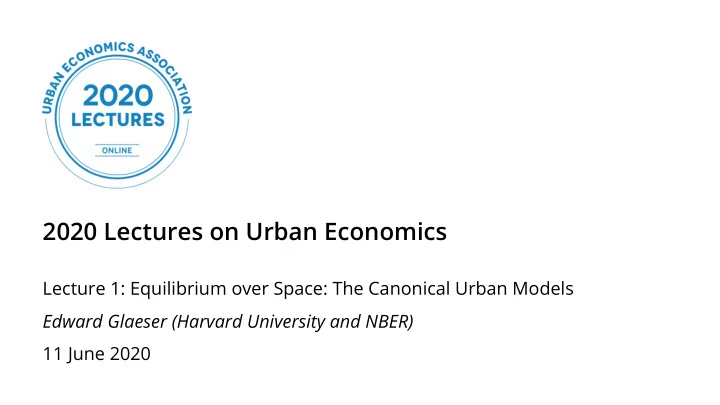

2020 Lectures on Urban Economics Lecture 1: Equilibrium over Space: The Canonical Urban Models Edward Glaeser (Harvard University and NBER) 11 June 2020
Equilibrium over Space: The Canonical Urban Models Edward Glaeser Harvard University and NBER
What is Urban Economics? • The study of the location of economic activity over space. • This is properly economic geographic, but it is subsumed in urban. • Urban is more fully focused on why things locate in particular cities. • Since proximity reduces transportation costs (for goods, people and ideas), transportation economics is a closely related field • How does location impact economic activity? • The economics of agglomeration is one subfield. • Human capital externalities; spillovers and neighborhood effects • What determines the price that people are willing to pay for particular places? • This is why real estate economics is also a close cousin of urban.
16000 18000 20000 22000 24000 Source: U.S. Census 0 2 Population Change, 2000-2010 Per Capita Income, 2000 Population Density 4 6 8 Average Population Change, 2000-2010 10 -.05 0 .05 .1 .15
Change in FHFA, 1996-2012 by Quintile of Population Density, 2010 .2 .15 .1 .05 0 1 2 3 4 5 Note: For MSAs with populations greater than 250,000 in 2010.
Predicted Telecommuting by Dingel and Neiman and Actual Telecommuting in the Alignable Survey
The Two Models: Within and Across Cities • The Alonso-Muth-Mills model (hereafter AMM) was produced in 1962. It characterizes a spatial equilibrium within cities. • It holds wages constant and focuses on commuting costs. • It is explicitly spatial in the sense that all locations are indexed by their proximity to a downtown where everyone works. • The Rosen-Roback model first emerged in 1979. It characterizes a spatial equilibrium across cities • It treats wages as endogenous, but does not really explain why productivity might differ across space. • Models of agglomeration economies start with Krugman (1992) will come in a later lecture. • It is a far less explicitly spatial model– locations are just different spots.
Components of Housing Rent (Graphs are from Denise DiPasquale)
Housing Rent Gradient in a Growing City
Extensions to Transportation Technologies • You can allow multiple types of linear transportation technologies, but for a fixed cost, you lower the variable cost. • For example, walking has the highest variable cost and no fixed cost, buses have a lower variable cost and a higher fixed cost, and cars have the lowest variable cost and the highest fixed cost. • Or you can allow an intensive investment– total cost is k+t(k)d. This will generate a first order condition of 1+t’(k)d=0 so that the investment rises with distance to the central business district. • Either of these changes the shape of the equilibrium bid rent curve and the shape of the density gradient.
Pascal’s Wager
Brookline: A Streetcar Suburb (S. B. Warner)
Elevated Railroads (NYC)
Multiple Income Groups • Allowing multiple income groups. With one technology, this means that greater demand for space by the rich battles against a higher willingness to pay to save time. • Becker originally claimed that the tendency of the rich to sort into the suburbs (in the US but not in Europe) reflects higher demand for land, but this requires an income elasticity of land demand (not housing demand which is slightly different) higher than the elasticity of travel costs with respect to income which seems unlikely to hold. • The alternative explanation is the with multiple technologies, the rich sort into driving zones, the poor walk and take public transportation. • See LeRoy and Sonstelie or my paper with Kahn and Rappaport.
An Empirical Puzzle: Manhattan House
Manhattan House Today
Recommend
More recommend